Understanding the humidity requirements of a succulent is important, otherwise you won’t be able to grow it properly.
So, do succulents like humidity? What do you think?
Well, succulents don’t particularly enjoy growing in an environment with high humidity levels. They can handle the heat but prefer dry heat over warm moist air. Generally speaking, an optimal humidity level for most succulent plants is 30-50%.
Additionally, knowing the requirements will help with placement and working out how to correct a problem if it arises.
Furthermore, without this knowledge, your plant can become damaged and possibly die. They start to sweat; the leaves stick together, leading to mold forming and throttling.
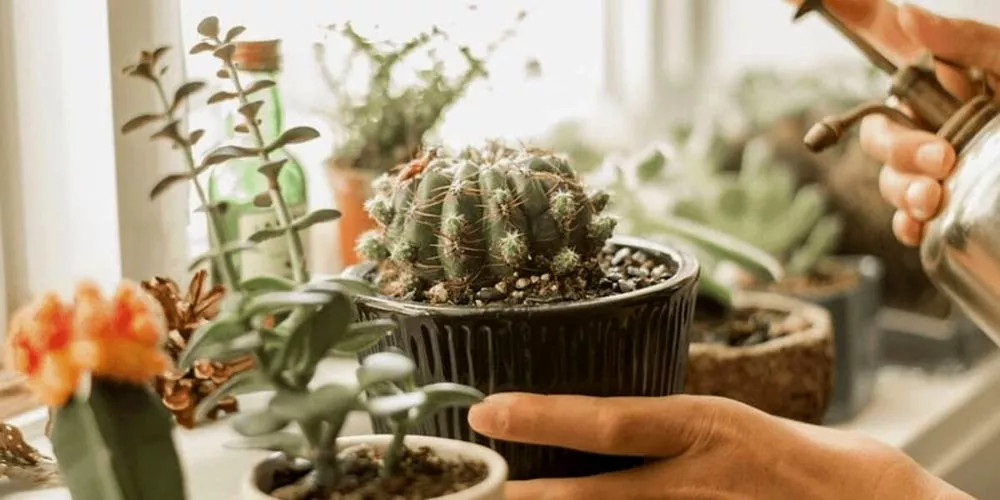
We know what comes after rot if not dealt with once discovered. If a succulent is growing in a region with predominantly high humidity levels, it’s best to have them potted indoors.
It’s also worth purchasing a dehumidifier in worse cases.
In this article, we’ll dive deeper into how humidity affects a succulent and some proven solutions to assist in helping them thrive otherwise.
Table of Contents
Understanding the Humidity
Humidity is simply the amount or concentration of water vapor that can be measured in the air in a given place at a given time. The more water vapor in the air, the higher the humidity and vice versa. Low humidity means there is less water vapor in the air.
When the humidity increases, you will feel more sticky and warm, and the air feels quite heavy.
Higher humidity is more common in Saudi Arabia, Oman, and Yemen, as well as South East Asia. E.g.: Thailand, Singapore, Malaysia, etc. They average anywhere between 50-70% during the year.
An average humidity level also considered comfortable is around 30-50%. Any higher and you will sweat and struggle to cool yourself down due to the stickiness in the air.
On the other end of the spectrum, countries with lower humidity levels include Portugal, France, Spain, Mexico, Costa Rica, and Panama, to name a few.
Do Succulents Like Humidity?
Succulents don’t enjoy high levels of humidity. They can handle 30-50% comfortably, which is the recommended comfort level for humans and/or animals. Anything higher can begin to cause damage to a plant of this nature.
They have these plump, lush leaves that already hold enough water to keep them happy, so they begin to sweat when you add more moisture into the air. Sweating causes rubbing and sticking.
This leads to the formation of mold and decaying leaves. Eventually, a plant can rot out and die if the issue is not corrected. It’s best to keep the humidity levels in the growing environment of a succulent down where possible.
How can you tell if a Succulent is getting too much humidity?
Succulents have their way of letting you know that there is too much humidity for them and that the levels should be adjusted.
Alternatively, you can use a hygrometer at regular intervals, so you are more in control and not relying on the plant.
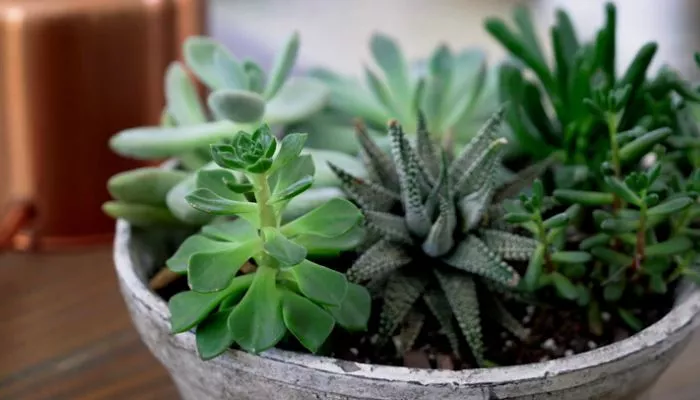
These devices measure the humidity and help you decide what action to take upon discovery. Here are a few of the signs that a succulent will provide of what to look for and get to know before it becomes too late:
- The tips of the leaves start to turn brown and begin to shrivel up and form a dark crust.
- The edges of the leaves may begin to fade into a pale yellow color which can lead to wilting.
- The smaller buds and/or flowers may begin to shrink and close up the shed in worse cases.
- The leaves may shed or fall if the plant is overly sensitive to drier air.
Effects of High Humidity on Your Succulents?
Several issues can arise when a succulent is grown in excessive humidity for long periods. The simple fix is to change the location to somewhere with less humidity or use a dehumidifier if the problem cannot be corrected.
The greater threat is that succulents can die if left to fend off mold, rot and other damaging issues for too long by themselves. They need attention.
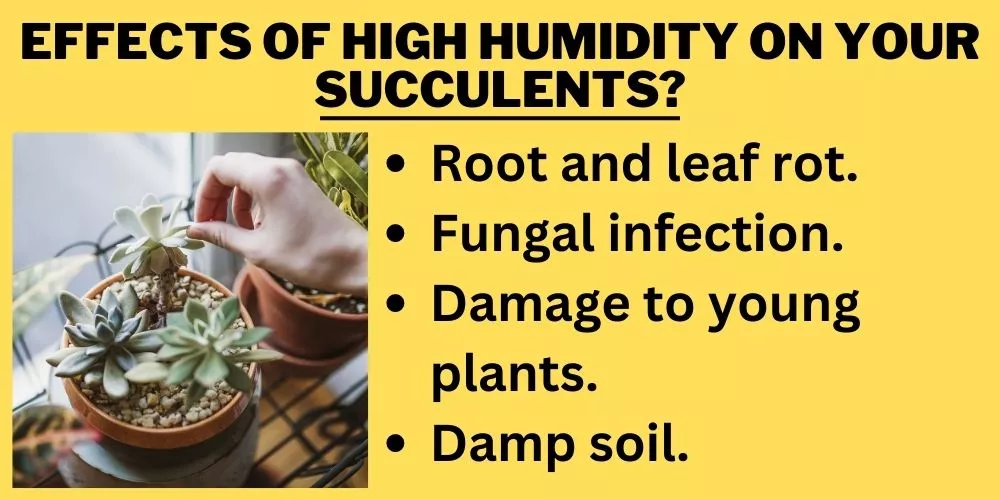
Once they begin facing these complications, the consequences can be much worse. Let’s look at the common problems caused by allowing a plant like this to be subject to higher than normal humidity levels.
Root and leaf rot
Root rot, in particular, is usually associated with overwatering. The plant receives too much water from several sources, and its roots sit in a pool of water underneath its soil. The roots stay wet and start to go soggy, then moldy, which is the principle of root rot.
The use of poorly draining soil can also amplify Overwatering. The water gets trapped and causes the same issues.
High humidity works in the sense that because a succulent is already holding/storing its water supplies, it struggles to soak in any other forms of water, let alone vapor, from the air (humidity).
The roots and leaves rot out as a result. It will start at the base with the roots and spread through the leaves. Also, mould will form if the sticky air lands on the leaves and isn’t assisted in drying off.
Fungal infection
Funnily enough, fungal infections can be blamed almost solely on overwatering and poor soil composition.
When water is left too long sitting on a stem or leaf, the surface moisture is stagnant, and the environment is primed for infestation of fungal diseases such as powdery mildew, leaf spot, mold, etc.
Additionally, succulents are used to dry environments and climates. As the atmospheric moisture swings more to a humid state, surface water increases, and spores begin to germinate, which triggers infection.
Damage to young plants
High levels of humidity can damage younger succulents much faster than mature plants. This is because they generally have not quite built up the strength to regulate their water stores, let alone withstand humid conditions.
Succulents have the uncanny ability to soak in the moisture from their surroundings via their leaves.
They then store the moisture there until times of need. Once they are full, any extra air moisture will become hazardous, especially for the younger plants.
Damp soil
Lastly, excess humidity needs somewhere to settle if the leaves of a succulent are already fully coated in moisture.
Where is this moisture forced to go? Liquids, especially water, will always run downwards. So, the final resting place for any excess deposits of air vapor will naturally end up in the succulent soil.
As this occurs, the soil becomes damp, more so if it is of poor quality and doesn’t drain as well as it should.
When the soil stays damp for too long, a range of issues occur in the form of diseases and attracting unwanted pests who love feeding on damaged plants.
Tips To Take Care Of Succulents In High Humidity?
Caring for your succulent when high levels of humidity are present is important for the overall longevity of the plant.
Here are some points worth noting to help ensure that your succulent has everything it needs to thrive and survive, especially in an environment with higher humidity than normal.
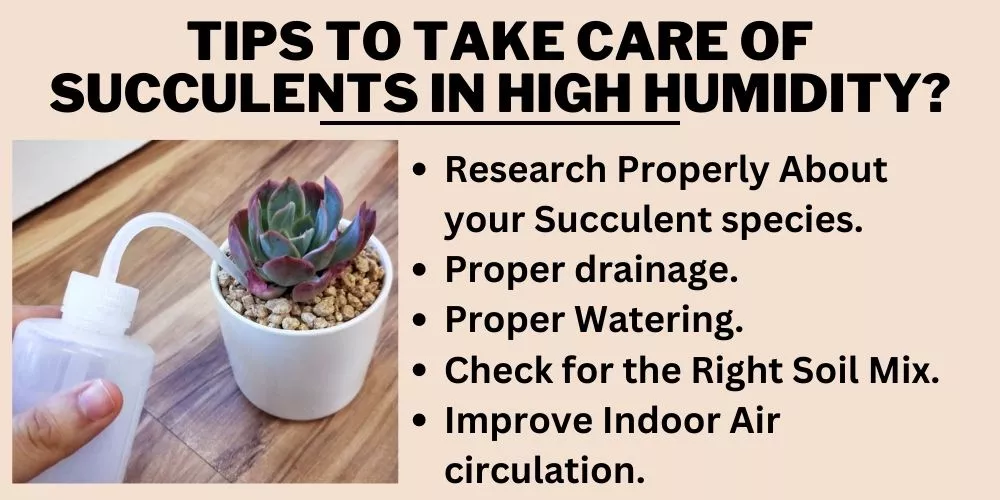
Research Properly About your Succulent species
One of the first steps that should be taken is finding out if your geographic location is safe for the species of succulent that you wish to grow.
If not, then you will always have that battle on your hands to control the environment to suit your plant. Whereas otherwise, you could be enjoying one more suited to your whereabouts.
Proper drainage
One of the key elements of a thriving succulent plant is the consistency and condition of the soil. Succulents prefer a more porous and well-draining blend.
They like to be watered sparingly, so it’s ideal to have that water flush through to refresh the soil and exit as soon as possible.
Ensuring the soil can drain away will also double as an extra drainage point for any humidity droplets left on the plant itself.
Proper Watering
There is no one rule for watering a plant of this nature. You should always read the signs of your plants and understand their needs.
Test the soil out by sticking your finger in to see the condition of the soil’s moisture. In saying that, succulents don’t require much in the way of water.
In fact, they should not be watered much during the winter months, if at all. During this period, they are dormant and won’t use any of their moisture stores.
Giving them water during this time will only cause their roots to rot, which would be considered overwatering.
That is unless the winters in your location are slightly warmer than others. In this case, they can be watered once in the middle of the winter period.
During the summertime, they may need a top-up of water. The frequency could be something like every 1-2 weeks.
Spring and fall may see them need a touch more water. E.g. once a week. Again, check the soil and see if the top 1-2 inches are dry; if it is, it’s safe to water them. Remember, keep the soil slightly moist but down-drown it.
Check for the Right Soil Mix
This couples with the soil being well draining. It’s super easy to make your soil blend. Use a potting mix as a base, add coarse sand or poultry grit, and finish with perlite or pumice. You start with the binding material and add the larger fractals to allow optimal water drain ability.
Improve Indoor Air circulation
Indoor air circulation plays a huge role in the humidity of a plant, especially a succulent. When air is stagnant in humid conditions, the moisture that sits on a succulent can cause collateral damage, such as leaf rot.
The plant’s leaves rub together and sweat and then begin to mold.
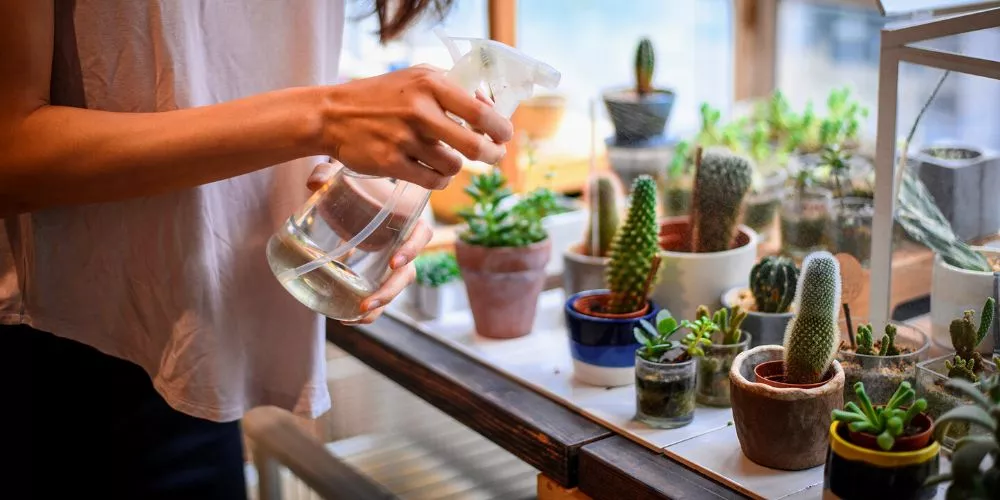
Suppose the air can be moved around via dehumidifiers or air conditioners. In that case, the moisture has less chance of landing on the plants and staying there for long enough to begin to deteriorate it.
Some Types of Succulents that prefer High Humidity
Besides the most common types of succulents that don’t thrive in humid conditions, some species are more tolerant to these higher humidity levels. The most well-known species include:
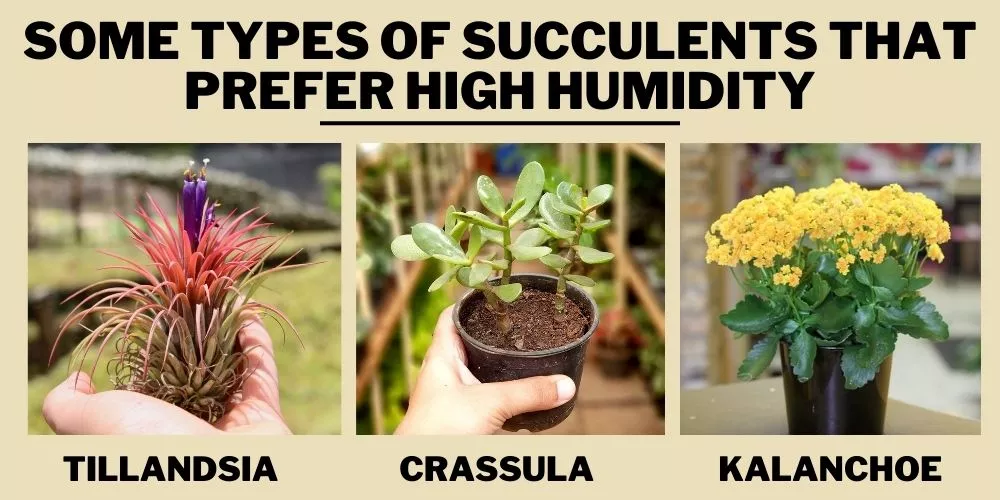
Tillandsia (Air Plants)
Air plants are special in the way that they pretty much grow in the air. These plants grow surprisingly well without soil and only require a light misting every 2 or so weeks.
The water that they do receive isn’t done the regular way. Instead, they are to be completely submerged for 20-30 minutes. They are a great plant for decorating glass containers such as terrariums.
Crassula (Jade Plants)
The Jade plant is similar to a Bonsai because it grows like a small tree. Their only 2 requirements are adequate light and water. They are easy to grow and, compared to most succulents, can grow in humid conditions.
Kalanchoe
These succulents flower in various colors such as red, magenta, yellow, orange and white. The beauty of them is the ease of growth and maintenance.
Furthermore, they can survive in high humidity levels without suffering from disease usually associated with these conditions.
What temperature do succulents like?
Succulents thrive best in milder temperatures; anything between the 40-70°F (5-20°C) range is perfect for them.
However, they can survive in much warmer temperatures by storing moisture and distributing it to themselves sparingly over time.
They do not do well under 40°F (5°C); freezing temperatures will damage the plants’ cell walls by exploding them once the moisture inside the leaves starts to freeze.
On the other end, extreme heats aren’t an issue for succulents. They originate in areas of higher dryer heat, so they are used to these types of environments.
Frequently Asked Questions (fAQs)
Do succulents like dry air?
Most succulent species thrive best in mid to high temperatures with dry air. They are used to arid climates. It’s the humid air that they don’t grow well in. When the air is dry, they use their water stores to regulate themselves in these conditions.
Is a humidifier bad for succulents?
Most succulent species do not enjoy humid conditions. There are the odd couple, but generally speaking, humid air makes them sweat and causes a range of diseases as a result. So a humidifier is not ideal equipment to use around succulents.
Do succulents like to be misted?
Succulents do not like to be misted. Misting a plant of this nature provokes or simulates humid conditions. There are, however, a small handful of succulent species that grow well in higher humidity. In general, though, succulents don’t thrive in humid conditions.
Final thought:
As we have discovered and covered, succulents do not like to be grown in high humidity conditions. They sweat and get sticky.
As the moisture gets trapped on the leaves and in the crevices, mold starts to form. If his process isn’t stopped early, the plant can suffer immensely.
We hope this article has helped you understand how humidity works with succulents and ways to reduce the risk in the future. Thanks for tuning in, and as always, happy growing!


